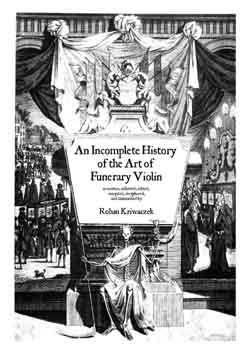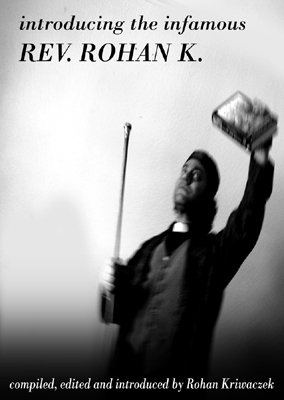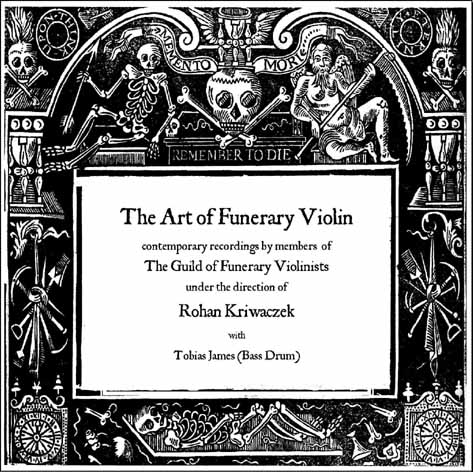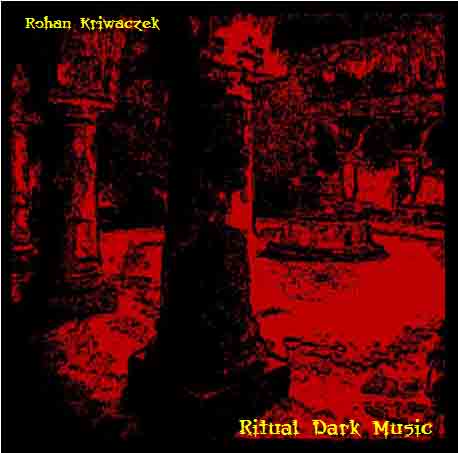to download this article as an ebook click here
page 5 of 7
The coffins, one full size, the other a little smaller, were solemnly paraded with myself at the head performing with great earnestness and, I might add, some considerable power and intensity. The graveyard, set just outside the small town, about 500 yards down the path towards the jetty, was relatively small, and the stones, which were left much in their natural state and were crudely carved with the names and fates of the dead, glistened in the reflected light of the fires which had been lit, one in each corner. The snow was still falling, though only lightly. Once we arrived the two boxes were placed into the two surprisingly shallow depressions that were cut into the frozen soil – I presumed they would be dug deeper come the springtime thaw – and all assembled stood in silent acknowledgement of my artistry whilst I played through eight of the great man’s works, with many improvised variations and developments. Oh I was a veritable Gratchenfleiss, and their delight and admiration was only just kept hidden beneath the necessity for a sombre visage of grief. Upon my conclusion I was left in no doubt as to the profound consolation I had offered them, both in terms of the expression of their grief in the correct manner, and the protection they felt I had offered their dead, through the magic of my violin. Finally the two boxes were piled with stones, each about the size of a fist, until the whole was entirely covered, at which point I turned and, with a dramatic flourish of my cloak, returned to the church, followed only by Sjöblom, placed my instrument in its case and headed back to the cave. My heart was beating with such vigour at the thrill of it all that I seemed to almost fly up the hill, with Sjöblom barely keeping up the pace. Oh historic day! May it be the first of many! A Triumph!
*****
Fascinating though this journal is (and it is without doubt the most detailed account yet discovered of the day to day life and mental vacillations of a Funerary Violinist, albeit in most unusual circumstances), its value as a contribution to the overall history of the genre is limited as Ola Nilsson himself wrote no music of his own and the dynasty he established had no influence whatever beyond Harstad and the neighbouring town (relatively) of Tromse. The following journals continue in much the same tone, with detailed descriptions of each funeral he participated in (271 in total over the following 25 years – which was a fair number considering that the population of Harstad given in the 1786 census was 662, and Tromse counted 560), alongside accounts of his day to day life: what he ate and drank; how often he beat his servant; and his many difficulties in getting money transferred from Stockholm: however, there are four specific funerals recounted that do at least establish him as the originator of a unique, if un-influential twist to the tradition. By the early 18th century Funerary Violin had become profoundly associated with the intention of assisting the spirit to pass over, and was always performed in the presence of the body, it being considered meaningless if the Dead are not within hearing. It was also a largely urban phenomenon, present in all cities and even smaller towns by 1700, though not unknown in many of the larger villages. Coastal towns and villages, whose inhabitants were largely fisherman by profession, often faced the spectre of death by drowning at sea, where recovery of the bodies was not an option, and the Funerary Violinist might perhaps play at the memorial, but the performance was generally considered to be of little more than symbolic value, being of no real use to the dead themselves. What sets Nilsson apart from the many hundreds of other coastal Funerary Violinists is his embrace of the pagan elements still very prominent in the Christianity of Northern Norway, and, in his self-appointed role as intermediary between this world and the fairy world of folklore, his willingness to develop the Art in whatever direction seemed necessary to further establish his position. Again, the author has deemed it appropriate to allow Nilsson himself to present the circumstances in his own words (considerably edited):
From Ola Nilsson’s Journal (volume 8):
March 27th 1790.
Around lunchtime Sjöblom came rushing in with a letter from the Elders of Tromse. I have been aware for a while now that my fame is spreading, and have been expecting this for some time. It seems that one of their fishing boats had been wrecked against the rocks in last week’s storm, killing all 12 men on board. They are deeply concerned for the spirits of the dead, who, having been denied a proper burial are in danger of turning to draugs, condemned to wandering the freezing waters for eternity, and they believe that my magic might relieve the situation. Not even the Pope can consecrate the sea, and yet they are calling for me! Am I now to be more powerful than all of their priests! I will, of course, leave tomorrow morning on a journey that should take no more than 2 days. A boat is awaiting us in Harstad, so at least we won’t have to suffer the indignities of Sjöblom’s donkey again. I shall wear my new bag-wig that arrived last week, perhaps with the blue powder, as I suspect that my beloved black periwig would not survive the journey: it has suffered much over the last few years with only Sjöblom to dress it, and its curls no longer hold for much more than half a day.
|







